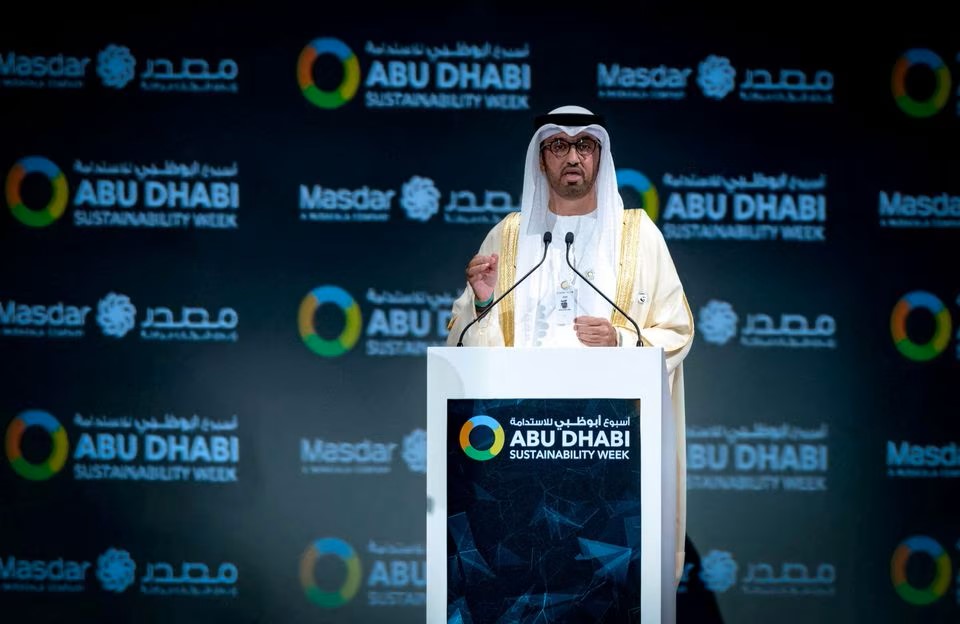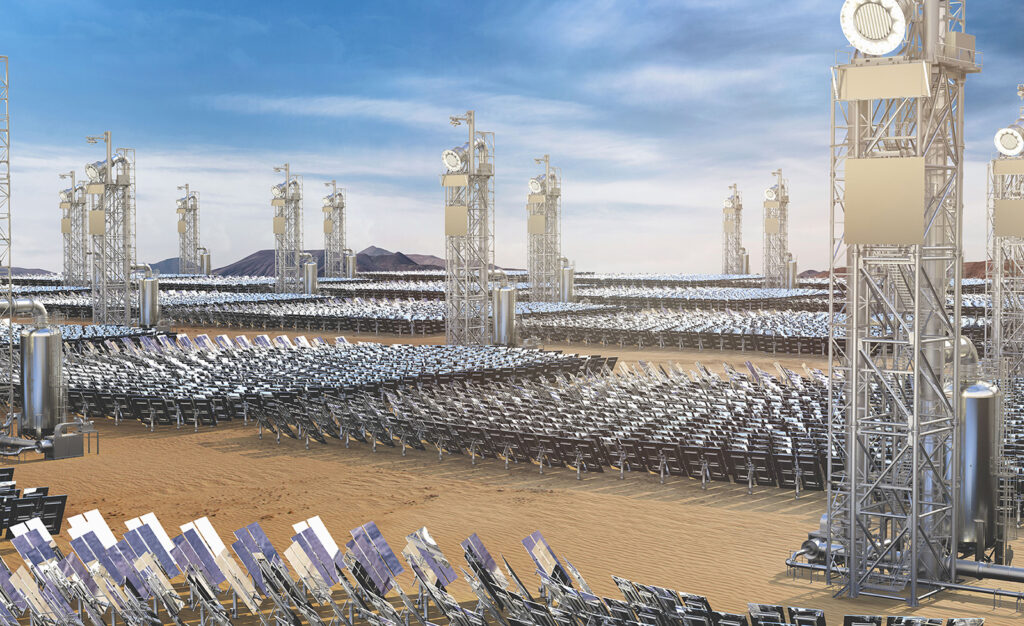UAE OIL CHIEF URGES BIG OIL TO COMBAT CLIMATE CHANGE

Reuters
H.E. Dr. Sultan Ahmed Al Jaber, UAE Minister of State and the Abu Dhabi National Oil Company (ADNOC) Group CEO, urged his peers at the CERAWeek energy conference in Houston, Texas, to join the fight against climate change. Borrowing a famous line from Apollo 13, he said, “Houston, we have a problem.”
According to Reuters he continued, “Energy leaders in this room have the knowledge, experience, expertise and the resources needed to address the dual challenge of driving sustainable progress while holding back emissions.”
“Alongside all industries, the oil and gas [industry] needs to up its game, do more and do it faster,” Jaber said. “We are not shying away from the energy transition. In fact, we are running towards it … The science is just clear. It’s crystal clear. We need to get fully behind net zero.”
Energy Wire reports that earlier, ADNOC had “signed a deal with Eni SpA, an Italian energy firm, to partner on a range of projects like new renewable and hydrogen projects, methane reduction and carbon capture. Still, ADNOC produces roughly 3 million barrels of oil daily, making it one of the world’s largest producers and biggest emitters.”
COP28 Controversy
Al Jaber is also president-designate of the upcoming U.N.-brokered COP 28 climate negotiations, which will be held in the United Arab Emirates starting in November. He was a controversial pick to lead the event because his country is an OPEC member and major oil exporter. The United Arab Emirates is only the second Arab state to host the conference, after Egypt in 2022.
Reporting for Reuters, Maha El Dahan writes, “The UN-backed climate change conference’s recent inclusion of oil and gas representatives is a far cry from 2021 summit, where energy companies complained they were shut out of the event.”
While activists worry that the oil industry was hijacking the world’s response to the global warming crisis, others say the whole energy industry needs to be involved in the energy transition, El Dahan writes. “Russia’s invasion of Ukraine sparked an energy crunch that underscored continued dependence on fossil fuels and vulnerability to supply disruptions.”
Read more from Reuters and Energy Wire here.
A ROUND-THE-CLOCK CLEAN ALTERNATIVE TO FOSSIL FUELS
400kWe 247Solar Plants deployed at scale
247Solar Plants™ bridge the gap between conventional wind and solar and the need for round-the-clock utility power and industrial-grade heat. 247Solar Plants store the sun’s energy as heat instead of electricity, for 9 hours or more, at much less than the cost of batteries. No generators are required, and 247Solar’s turbines can also burn a variety of fuels, including hydrogen, to ensure 24/7/365 dispatchability.
Extensive Applications
On-grid or off-grid, 247Solar Plants offer a 24/7 alternative to fossil fuels for a broad range of applications:
- CHP: 24/7 low-carbon Combined Heat & Power for industry
- Ultra Heat: Each 247Solar Plant can provide up to 1,500,000 Btu/hr. of heat at temperatures up 1000℃/1800℉ for industrial processes such as cement, glass, steel making, or minerals processing
- Microgrids: Always-on, emissions-free electricity and heat for islands, mines, communities, facilities
- 24/7 baseload power: 24/7 solar electricity, especially for emerging economies
- Green Hydrogen: 24/7 solar electricity and heat to power electrolysis around the clock
- Green Desalination: 24/7 solar electricity and heat to purify water around the clock
ALSO FROM CERAWEEK – U.S. PERMITTING CHANGES

CERAWeek via E&E News
CERAWeek is one of the world’s premier energy conferences, hosted each year by famed energy intellectual Daniel Yergin. The event brings together executives from across the energy sector — from oil majors and national oil companies to natural gas companies and renewable energy developers.
Among these was John Podesta, senior adviser to U.S. President Joe Biden. Energy Week reports that at the conference, a long list of policymakers and industry players called for changes to the permitting process for U.S. infrastructure.
EW quotes Podesta as saying, “I’ve worked in three White Houses. Permitting has never been a top priority of senior administration officials in the past. Now, thanks to President Biden, it is.”
“We’re doing what we can with the tools we have,” he added. “We can move faster by setting tighter deadlines for agencies to complete environmental reviews. We can move smarter by making it easier to approve projects with low environmental impact … But Congress needs to do its job too.”
This could be an area of rare bipartisan agreement in the United States. EW reports that Republicans in Congress are starting to move permitting proposals through the House. “Key changes include provisions setting shot clocks and page limits for environmental reviews and restricting the opportunities for legal challenges.”
Read more here.
ANALYST: EMERGING TECH NOT THE NEAR-TERM SOLUTION
There is no shortage of innovation and money being directed toward clean energy solutions, but we can’t afford to wait for them. So argues energy analyst Michael Liebreich in The Economist.
Existing clean energy technologies — principally solar PV and wind — are often dismissed because their intermittency suggests they can’t be the basis for a round-the-clock renewable solution. But, Liebreich points out, “wind and solar are now the cheapest way of generating electricity almost everywhere.” Also, “the cost of short-term storage has plummeted. So while wind and solar now produce electricity more cheaply than ‘baseload’ plants, batteries can fill most supply gaps more cheaply than ‘peaking’ plants.”
Though some may reject the notion, he says, “we can keep using fossil fuels a few weeks a year as long as we capture from the air the equivalent amount of the carbon dioxide they emit. This will cost an expensive (but not unaffordable) $200 per tonne and still allow us to get to net zero.”
The rub is that the world needs to make progress on decarbonization now if it is to hope to achieve its targets for 2050 and beyond. While he notes progress toward green hydrogen at scale, small-scale nuclear and even fusion power, “the decades it takes for new energy and transport technologies to get to global scale means we cannot afford to wait.”
Instead, he cites the example of the simple heat pump. “It turns out there is a commercially available technology that already beats that fusion breakthrough—by a factor of around 400. If you were to put the same 300MJ of electricity into a modern domestic heat pump, you would get around 1,200MJ worth of heat. Heat pumps are not a nascent technology … But this is precisely the kind of technology we should be rolling out as fast as we can.” That, plus more solar and wind.
Read more here
NEWS FROM 247SOLAR
247Solar and Morocco’s Mohammed VI Polytechnic University to Study Solar-Powered Green Hydrogen and Ammonia Technology
 247Solar has signed a Memorandum of Understanding (MOU) with Morocco’s Universite Mohammed VI Polytechnique (UM6P) to study the production of Green Hydrogen and Ammonia powered by 247Solar’s innovative next-generation Concentrated Solar Power (CSP) and thermal energy storage technologies.
247Solar has signed a Memorandum of Understanding (MOU) with Morocco’s Universite Mohammed VI Polytechnique (UM6P) to study the production of Green Hydrogen and Ammonia powered by 247Solar’s innovative next-generation Concentrated Solar Power (CSP) and thermal energy storage technologies.
The undertaking is intended in part to demonstrate the feasibility of producing Green Hydrogen/Ammonia to decarbonize fertilizer production, and is being partially funded by Morocco’s OCP Group, the world’s largest producer of phosphates. (Ammonia and phosphoric acid are used to produce ammonium hydrogen phosphate, a common inorganic fertilizer.)
Under the MOU, the parties form a strategic partnership to study the integration of green electricity and heat to supply two initial Green Hydrogen and Ammonia Pilots, and to explore its feasibility for large-scale production of green hydrogen and ammonia and possibly green desalination systems as well.
Read our press release here.
FOLLOW & JOIN 247Solar
LinkedIn US, LinkedinEU, Twitter, YouTube
Contact: info@247solar.com
